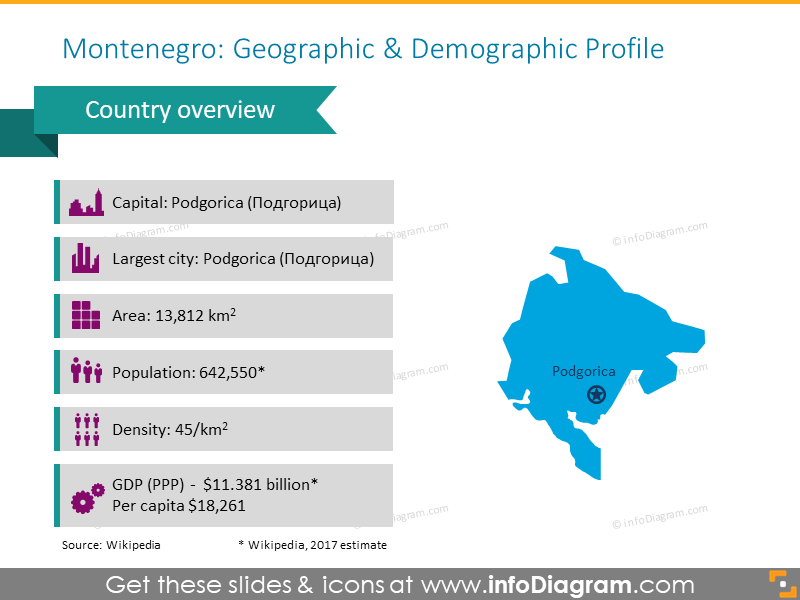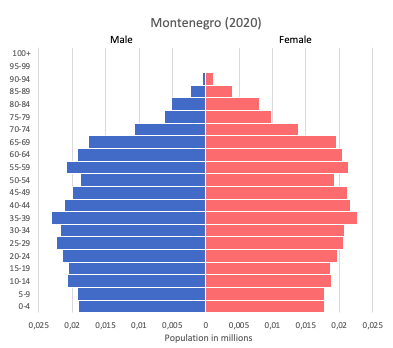Montenegro’s Demographic Shift: Navigating Opportunities In 2025
Montenegro’s Demographic Shift: Navigating Opportunities in 2025
Related Articles: Montenegro’s Demographic Shift: Navigating Opportunities in 2025
Introduction
With great pleasure, we will explore the intriguing topic related to Montenegro’s Demographic Shift: Navigating Opportunities in 2025. Let’s weave interesting information and offer fresh perspectives to the readers.
Table of Content
Montenegro’s Demographic Shift: Navigating Opportunities in 2025

Montenegro, a picturesque Balkan nation known for its stunning coastline and rich history, is poised for significant demographic changes in the coming years. Projections indicate that the country’s population will experience a gradual decline, with a projected population of around 630,000 by 2025. While this demographic shift presents challenges, it also unlocks a unique set of opportunities for the nation’s social, economic, and political landscape.
Understanding the Demographic Landscape:
The anticipated population decline in Montenegro is primarily driven by several factors:
- Low Birth Rates: Montenegro has consistently experienced low birth rates, resulting in a shrinking population base. This trend is further exacerbated by emigration, as young people seek better economic opportunities abroad.
- Aging Population: As the population ages, the dependency ratio (the proportion of non-working age individuals to working-age individuals) is expected to increase. This trend necessitates a focus on healthcare, social security, and long-term care services.
- Emigration: Montenegro’s relatively small economy and limited job opportunities have led to a significant outflow of young, skilled workers. This brain drain has a detrimental impact on the country’s economic growth and development.
Opportunities Arising from the Demographic Shift:
Despite the challenges associated with a shrinking population, Montenegro can leverage this shift to its advantage by strategically focusing on the following opportunities:
1. Economic Diversification and Innovation:
- Attracting Foreign Investment: The demographic shift presents an opportunity to attract foreign investment, particularly in sectors that require skilled labor. A focus on attracting technology companies, research and development centers, and high-value tourism can create new job opportunities and stimulate economic growth.
- Developing a Knowledge-Based Economy: Investing in education and training programs can equip the workforce with the skills needed to thrive in a globalized economy. This shift towards a knowledge-based economy can attract talent and foster innovation.
- Promoting Entrepreneurship: Encouraging entrepreneurship can create new businesses and stimulate economic activity. This can be achieved through favorable policies, access to funding, and mentorship programs for aspiring entrepreneurs.
2. Sustainable Development and Environmental Protection:
- Promoting Sustainable Tourism: Montenegro’s natural beauty can be leveraged to attract environmentally conscious tourists who prioritize sustainable practices. This can generate revenue while preserving the country’s natural resources.
- Investing in Renewable Energy: With a focus on renewable energy sources like solar and hydropower, Montenegro can reduce its carbon footprint and contribute to global efforts towards climate change mitigation.
- Protecting Biodiversity: The decline in population presents an opportunity to prioritize environmental protection and preserve Montenegro’s rich biodiversity. This can contribute to the country’s long-term sustainability and attract eco-tourists.
3. Social Welfare and Inclusivity:
- Strengthening Social Safety Nets: The aging population necessitates robust social safety nets to support older adults and ensure their well-being. This includes expanding access to healthcare, social security, and community care services.
- Promoting Social Inclusion: Addressing the needs of vulnerable populations, such as the elderly, disabled, and minorities, is crucial for creating a more inclusive society. This can be achieved through targeted programs and policies that promote social integration and empowerment.
- Enhancing Healthcare and Long-Term Care: Investing in healthcare infrastructure, training healthcare professionals, and developing long-term care facilities are essential to meet the needs of an aging population.
4. Political and Institutional Reforms:
- Strengthening Governance: The demographic shift highlights the need for efficient and transparent governance to address the challenges and opportunities presented by a shrinking population. This includes reforming public administration, promoting transparency, and strengthening democratic institutions.
- Empowering Local Communities: Decentralizing decision-making and empowering local communities can foster greater civic engagement and ensure that policies are tailored to specific regional needs.
- Promoting Civic Participation: Engaging citizens in the decision-making process is crucial for building a more resilient and responsive society. This can be achieved through participatory budgeting, public consultations, and other mechanisms for citizen engagement.
FAQs about Montenegro’s Demographic Shift:
Q: What are the potential consequences of a shrinking population in Montenegro?
A: A shrinking population can lead to a decline in economic activity, a strain on social services, and a decrease in the workforce. It can also lead to a decline in the tax base, making it more challenging to fund public services.
Q: How can Montenegro attract foreign investment and skilled workers?
A: Montenegro can attract foreign investment by creating a favorable business environment, offering tax incentives, and promoting its strategic location and natural resources. It can also attract skilled workers by offering competitive salaries, access to quality healthcare and education, and a high quality of life.
Q: How can Montenegro address the challenges of an aging population?
A: Montenegro can address the challenges of an aging population by investing in healthcare, social security, and long-term care services. It can also promote active aging and encourage older adults to remain engaged in society.
Q: What are the potential benefits of a shrinking population for Montenegro?
A: A shrinking population can lead to a reduction in environmental pressure, improved access to resources, and an opportunity to create a more sustainable and equitable society. It can also lead to a more efficient allocation of resources and a greater focus on innovation and technology.
Tips for Navigating Montenegro’s Demographic Shift:
- Prioritize Education and Skills Development: Investing in education and training programs is crucial to equip the workforce with the skills needed for the future.
- Promote Innovation and Entrepreneurship: Creating a favorable environment for entrepreneurship can stimulate economic growth and create new job opportunities.
- Embrace Sustainable Development: Focusing on sustainable tourism, renewable energy, and environmental protection can preserve Montenegro’s natural resources and attract environmentally conscious tourists.
- Strengthen Social Safety Nets: Expanding access to healthcare, social security, and community care services is essential to support older adults and vulnerable populations.
- Foster Civic Engagement: Encouraging citizen participation in the decision-making process can build a more responsive and resilient society.
Conclusion:
Montenegro’s demographic shift presents both challenges and opportunities. By strategically addressing the challenges and leveraging the opportunities, Montenegro can build a more prosperous, sustainable, and inclusive society. The key lies in embracing innovation, promoting sustainable development, strengthening social safety nets, and fostering civic engagement. By navigating the demographic landscape effectively, Montenegro can secure a brighter future for its citizens.








Closure
Thus, we hope this article has provided valuable insights into Montenegro’s Demographic Shift: Navigating Opportunities in 2025. We thank you for taking the time to read this article. See you in our next article!